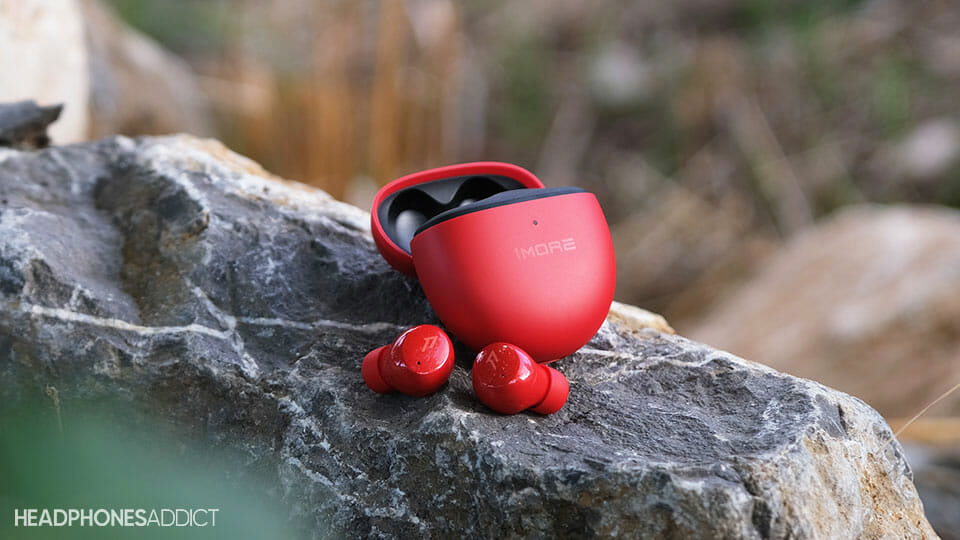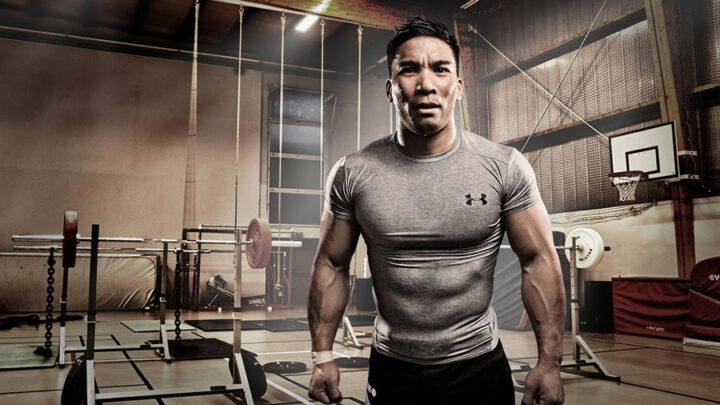Here are the best headphones for cycling in 2023.
We tested 192 headphones, including 84 cycling-oriented headphones (water-resistant, earbuds, small design).
Apart from the standard criteria, we ranked headphones on:
- Fit under a helmet
- Water resistance
- Wind noise (especially at high speeds)
Here are the top 9 out of all we tested.
You don’t want to spend real money on new headphones only to realize they DON’T WORK on a bike. Or worse, end up dead when getting caught in the rain.
We guarantee if you get any headphones below, this won’t happen (unless you drive over them. Then all bets are off).
Quick Overview of The Best Cycling Headphones
If you know what you’re looking for, here are the top choices in a nutshell.
| Rating | Price | Water protection | Connection | Battery (charging) | Mic & Controls | Read more | |
|---|---|---|---|---|---|---|---|
|
Jaybird Vista 2
#1 Best for cycling
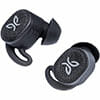
|
4.3
|
Under $200
|
IP68 (IP54 on case)
|
Bluetooth 5.2
|
8 hours, 16h in case (USB-C & Qi wireless charging)
|
|
|
|
Jabra Elite 7 Active
Runner-up
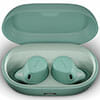
|
4.1
|
Under $180
|
IP57
|
Bluetooth 5.2
|
8 hours, 22h in case (USB-C & Qi wireless)
|
|
|
|
Beats Fit Pro
Best for iPhone
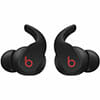
|
4.5
|
Under $200
|
IPX4
|
Bluetooth 5.0
|
6 hours, 18h in case (USB-C)
|
|
|
|
Shokz OpenRun Pro
Best awareness
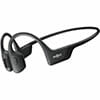
|
4.6
|
Under $180
|
IP55
|
Bluetooth 5.1
|
10 hours (proprietary)
|
|
|
|
TOZO OpenReal
Best awareness
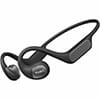
|
4.7
|
Under $50
|
IPX8
|
Bluetooth 5.3
|
12 hours (proprietary charger)
|
|
Best Headphones for Cycling
1. Jaybird Vista 2

Key Features:
- Great sound quality out of the box with less wind noise
- Stable and comfortable under a bike helmet thanks to ear wings
- Durable, IPX8 (IP68): Resistant to water and dust
- Over 8-hour battery life
- Feature-rich companion app
Pros & Cons
- Great sound for all music genres you can fully customize with EQ & presets
- They stay comfy and stable in your ears during activity, even when sweaty
- Can easily survive dust AND water, even submerging
- 8-hour+ battery provides convenience without worrying about charging
- Fully customize the earbuds to fit your needs in the companion app
- Removes background noise with ANC so you can focus on the workout
- Occasional connection stutters
- Annoying errors during firmware updates
Jaybird Vista 2 are the best cycling headphones with excellent sound quality, ambient-aware mode, waterproof casing, and stable fit under a helmet.
These true wireless headphones are the best choice for anyone wanting to listen to music or podcasts while riding a bike. They fit like a glove. Once you pick the right tips and ear wings, they stay put even during fast movement.
Staying safe is important too. Thanks to a capable ambient-aware mode, you can HEAR THE TRAFFIC before an accident happens.

Most other TWS headphones either struggle with the fit under a helmet, don’t sound good, their ambient-aware mode sucks, or aren’t waterproof. The Jaybird Vista 2 tick all the boxes.
Don’t believe us they sound good?
Here’s the Jaybird Vista 2 A/B Sound Test:
The Vista 2 earbuds have a smooth, balanced sound. And you can fully tweak it in the app’s EQ (equalizer).
You can also choose from community EQ presets or let the Jaybird app create a personalized EQ just for you. That’s the level of customization we like to see.
Despite their bulky construction, WIND NOISE isn’t a huge problem. The outer side is covered in mesh which produces less wind friction. And it doesn’t hurt mic quality during phone calls, either.
Earbuds are pretty comfortable and offer a stable fit thanks to ear gels with wings. Physical buttons are easy to use, with all the controls you need. So you can keep your phone in a pocket.
The best thing is durability: These earbuds have the MIL-STD-810G shockproof standard and an IP68 water resistance certification.
You can treat them badly, and they won’t die on you. If you get them dusty (other earbuds would stop working) just wash them in water. Wipe the water off. And they’re ready to go.
Jaybird Vista 2 are hands-down the top contender for cycling and other sports:
- Suitable for all music genres: Rich EQ options and presets ensure you’ll love the sound.
- Stable and comfortable when riding a bike: The ear wings ensure stability while their smart design minimizes wind noise.
- IPX8 (IP68): Though earbuds that can withstand dust and water, so you never have to worry about breaking them.
- 8-hour+ battery: Use them multiple times per charge without worrying about battery life.
- Solid Jaybird warranty: If they die on you, Jaybird will replace them free of charge.
It’s not uncommon for Jaybird earbuds to stop working for no good reason. Thankfully, they respect their warranty and promptly deal with each case (we had to replace our Vista 2’s due to some problems, and it went hassle-free).
So, if you’re looking for top-of-the-line sports earbuds for cycling, Jaybird Vista 2 won’t disappoint. They’re the whole package with more features than you’d expect.
Related:
2. Jabra Elite 7 Active
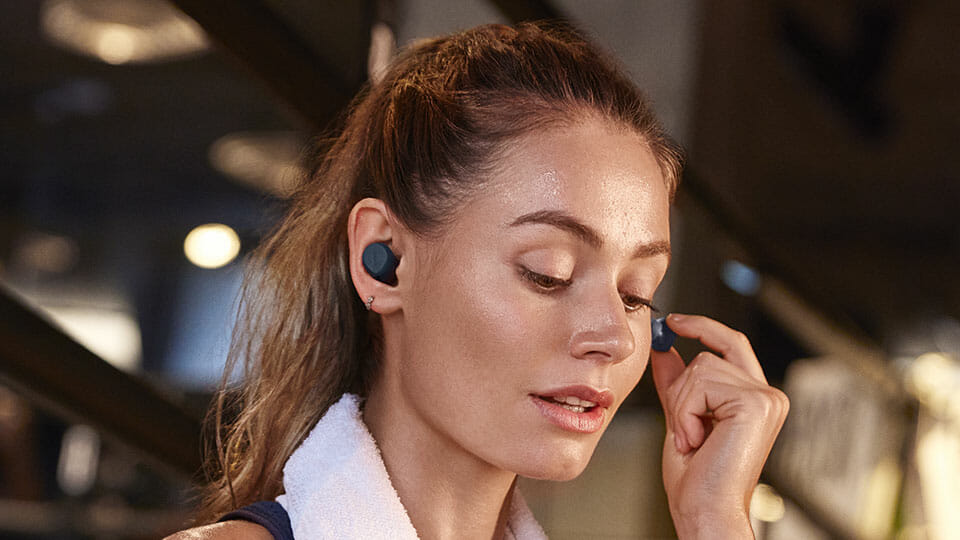
Key Features:
- A stable fit without ear wings or hooks that irritate ears (fit under a helmet)
- Waterproof, IPX7 (IP57): Capable of withstanding submerging in water AND dust
- 8-hour+ battery life per charge
- Decent active noise cancellation (ANC)
- Customization app
Pros & Cons
- Natural sound that sound good for all music genres
- Comfortable fit you can wear for hours
- Decent ANC that removes background noise
- Feature-rich app with EQ, control customization and more
- Wind hurts the ANC
- Not the most secure fit out there
Jabra Elite 7 Active are one of the best cycling headphones for those who don’t like ear wings and hooks.
If you don’t like the feeling of ear wings touching your ear lobes, then check out the Jabra Elite 7 Active. These Bluetooth earbuds are the top choice for cyclists who want a good fit but without earwings or hooks.
They still fit well under a helmet thanks to their ergonomic design that adapts the the shape of ears. They’re waterproof, sound good and offer plenty of customization. A great choice to use when hopping on a bike.
How do they sound?
Instead of deep bass (like on Jabra Elite Active 75t), the new Elite 7 Active have a balanced sound signature. Albeit still fun for music, the earbuds are slightly more detailed and natural overall.
The earbuds adapt to your ears due to their ergonomic design. So, they stay inside your ears even if you jump around like crazy (during intense workouts).
What about wind noise on a bike?
Special SAATI Acoustex mesh ensures less wind noise during phone calls, while the earbud’s flush design also reduces wind noise during running and cycling. There is some (like with all earbuds), but it’s not too bothersome.
Also, with the Jabra app, you can create custom controls, EQ the sound to your liking, and find your lost bud with the “find my buds” feature. And they are reliable due to Bluetooth 5.2, so you don’t get interrupted by connection stutters.
ANC is decent. You get active noise cancellation that removes noises on a gym stationary bicycle. And ambient sound mode to amplify ambient noise for better awareness when cycling outside.
Nonetheless, Jabra Elite 7 Active are among the best headphones you can choose for cycling:
- Neutral sound is suitable for listening to all music genres, podcasts, videos, etc.
- Stable without ear wings: They stay in during movement.
- ANC for indoor cycling: Remove distractions and focus on your workout on a stationary bike.
- Ambient-aware mode for outside: It makes you aware of your surroundings, so it’s safe to cycle.
- Capable app: Plenty of customization makes it possible to set the earbuds just how you like them.
While the stability of the fit isn’t as good as with the earbuds that use ear wings and hooks, it’s not much worse. And, using ANC outside isn’t optimal. The wind messes it up and makes ANC worse. But you should use ambient-aware mode anyway.
If you want the best headphones without ear wings for cycling, get the Jabra Elite 7 Active. These premium TWS earbuds are, though, feature-rich and sound good. A perfect gadget for cycling.
Check related: Best bass earbuds
3. Beats Fit Pro
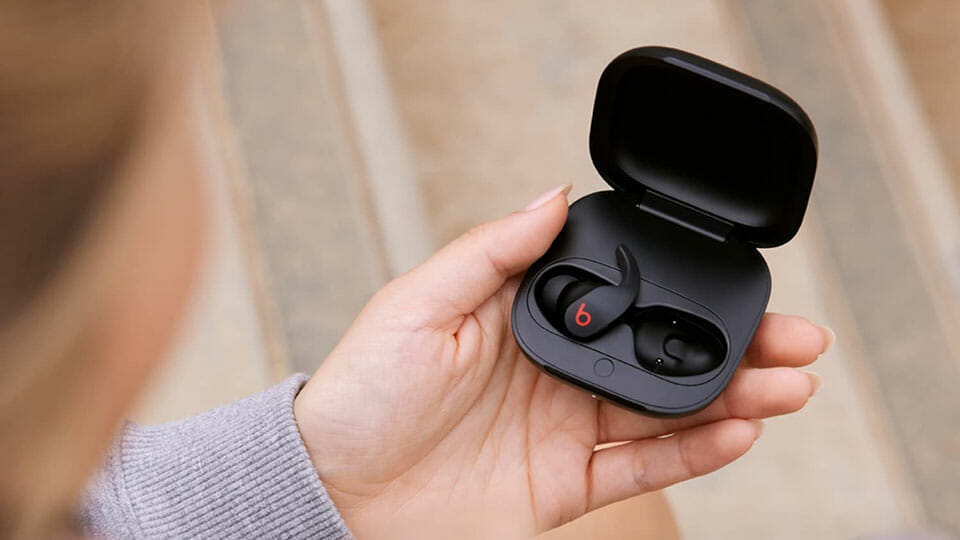
Key Features:
- Fun, dynamic sound with a good punch
- They are stable under a helmet thanks to ear wings that keep them in place.
- Transparency (ambient-aware mode) keeps you safe on the road
- The least amount of wind noise of all Beats headphones.
- Resistant to sweat and rain: IPX4
Pros & Cons
- Fun sound with a good bass punch
- Comfortable & stable fit: Suitable for sports and activity
- Good ANC performance that removes background noise
- Apple's Spatial Audio that recreates a life-like listening experience
- Many features not supported on Android
- No Qi wireless charging
Beats Fit Pro are great fitness earbuds that work for cyclists with an iPhone (and other sports).
These true wireless earbuds are the best choice for cyclists with an iPhone. The Apple ecosystem makes using these a breeze with many good features.
Apple AirPods Pro 2nd. gen or regular AirPods don’t stay in the ears well, which is a problem when riding a bike. The Fit Pro don’t suffer from this problem.
What features do you get with an iPhone?
Using these with an iPhone is simple, thanks to the H1 chip. Your phone automatically finds the earbuds without bothering with manually paring. All the customization is available on the iPhone (most of this is locked on Android).
But…
With the Beats app, you can access some features on Android too. They support ANC and Transparency mode (ambient-aware mode).
Active noise cancellation removes background noise if you’re cycling on a stationary gym bicycle. With Transparency mode, you can hear the traffic and noises around you. It’s much safer to ride.
And they’re true wireless, so no wires to tangle into your helmet. Wearing a bicycle helmet is no problem.
Also, the earbuds are pretty tiny and have a built-in ear fin. It’s much smaller than a hook. It makes them very comfortable and stable, especially during sports & activities (cycling included).
How’s the sound?
Unlike the PowerBeats Pro model, the Fit Pro are much tamer. They have a brighter signature that’s still punchy but not boomy. Thanks to Adaptive EQ, the sound adapts to your ear’s shape. So, you get great sound quality even if you have weird ears.
The battery life of 6 hours is good enough for a lengthy ride. Popping them into the charging case will fast charge them, on top of giving you an extra 18 hours.
Beats Fit Pro are the top choice for an iPhone user:
- Fun sound with Adaptive EQ that changes the audio to fit your ears.
- Stability: Ear fins and ergonomic design make them stable. No need to constantly readjust the fit.
- ANC & Transparency mode: Remove distractions when cycling inside and keep awareness when on the street.
- Water resistant: IPX4 protection easily survives rain.
- H1 chip: All the benefits of the Apple ecosystem that create a fantastic user experience.
On the other hand, don’t get these if you have an Android phone. You miss on features like Adaptive EQ, control customization, and seamless pairing, which makes the earbuds an average option.
If you’re looking for headphones that are great for cycling AND you have an iPhone: Get Beats Fit Pro. Apple made these the perfect gadget for hopping on a bike with an iPhone in a pocket.
4. Shokz OpenRun Pro
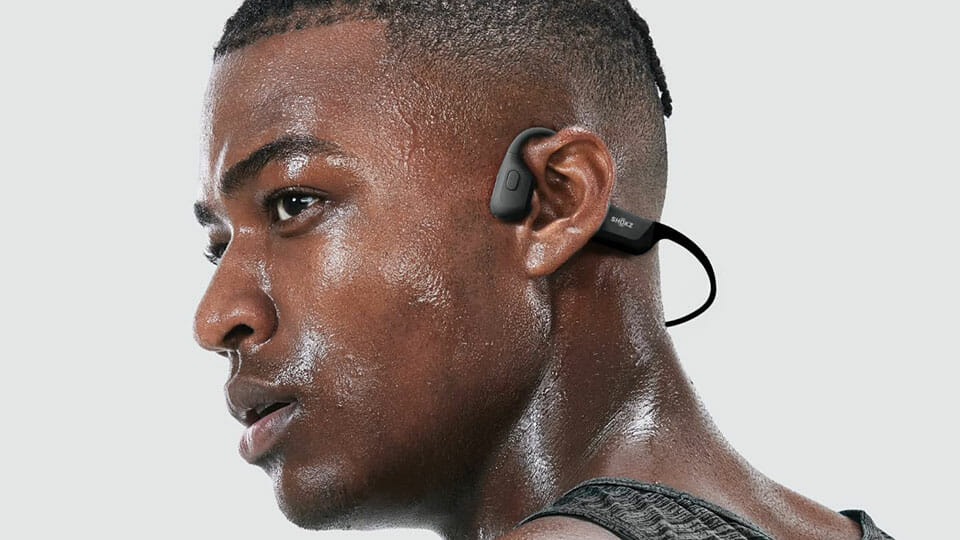
Key Features:
- Open fit leaves your ears open
- Super stable
- Good battery life of 10 hours + quick charging
- IPX5 (IP55) water & dust resistance
- Can fit under a helmet, EVEN with a headband design
- The best sound of bone conduction headphones
Pros & Cons
- Fun sound quality with more bass than other bone-conducting headphones
- Long 10-hour battery life with quick charging (0-100% in 1 hour)
- Ergonomic and lightweight, Comfortable and stable fit for all activity
- Vibrating transducers can be annoying
- Proprietary charging cable
Shokz OpenRun Pro are the best bone-conduction headphones for cyclists.
These are for you if you DON’T LIKE THE FEELING of in-ear headphones rubbing inside your ear canal.
Bone conduction headphones have long been a great sports and awareness alternative to regular headphones. And the Shokz OpenRun Pro are the best among them.
What makes them the best?
The open-ear fit leaves your ears open to the environment. You can hear everything that’s going on around you. It makes it much SAFER to cycle on busy streets and avoid danger (oncoming traffic).
They fit well under a bicycle helmet, too. While their design is bigger, it’s relatively thin. The headband curves lower than the ear level, making it possible to wear a helmet without problems.
How’s the sound?
Sound quality is among the best in bone-conduction headphones. These have a balanced sound signature that sounds good for all music genres.
The only thing missing is a bit of bass power. But this comes with the design. Most bone-conduction headphones have less bass. While the OpenRun Pro suffer the least from it thanks to TurboPitch technology (it boosts bass).
How tough are they?
With IP55 water and dust resistance, you can easily get caught in the rain or get them dusty. It doesn’t bother them.
Shokz OpenRun Pro offer things important for cycling:
- Perfect awareness of the surroundings thanks to the open-ear fit, so you can stay safe.
- Stable and comfortable under a helmet, you can wear them for hours.
- Durable: Resistant to water and dust (IP55), so you can wear them in the rain.
- 10-hour battery: With 10 hours of battery life, you can take them on long cycling trips and charge them in 1 hour.
But you have to expect more wind noise due to the larger casing. It comes with the type of headphones. You gain an open-ear fit but lose on wind noise. It’s a compromise.
So, for the best bone-conduction headphones for cycling, check the Shokz OpenRun Pro. You benefit from the open-ear fit, making it the safest headphones to wear on a bike.
(There’s also another type of open-ear headphones. See below).
5. TOZO OpenReal
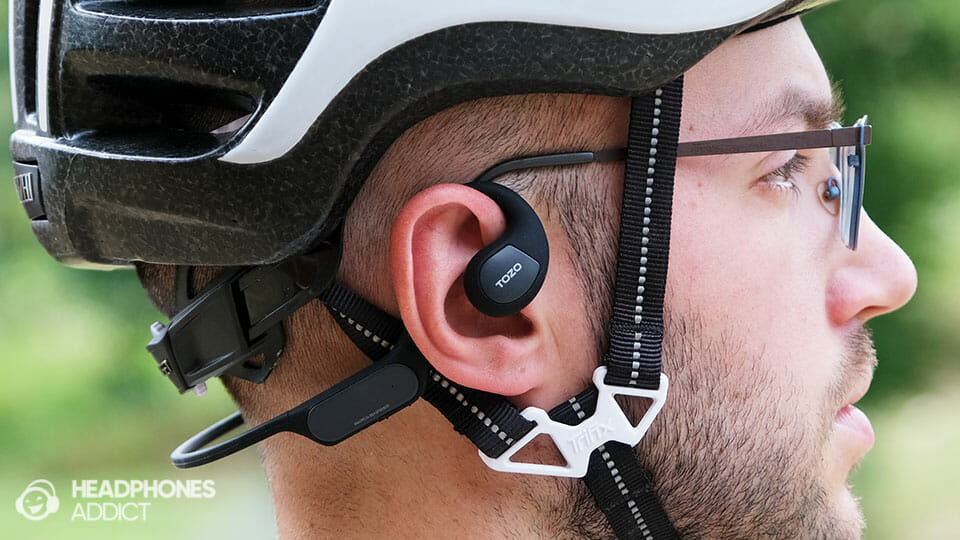
Key Features:
- Open-ear fit leaves your ears open to the environment
- Lightweight design that fits under a bike helmet
- 12-hour+ battery life
- Natural, high-quality sound
- Built-in controls
Pros & Cons
- Incredibly natural tuning, especially after EQ
- Ergonomic design for rock-solid stability
- Comfortable to wear & compatible with bike helmets
- Good battery duration of 12 hours per charge
- Exceptional Bluetooth indoor range of 65 feet
- Annoying proprietary charger with weak magnets
- No support for Bluetooth multipoint or Game mode
TOZO OpenReal are the best headphones for bike riding with full awareness and great sound quality.
The whole team agreed TOZO OpenReal were the best cheap headphones for cycling. These are the Neil Armstrong on-a-budget.
They offer everything you’d expect from headphones made for cycling. They’re tough, comfortable, sound good, and are easy to use. All for under $50.
What more can you ask for?
Granted, the only thing missing is ANC for those gym cycling sessions. But for the outdoors, they’re a blast.
The open-ear fit helps you hear everything around you. You can stay away from oncoming traffic, dogs, or patrol cars chasing after you (if that’s how you roll).
How do open-ear headphones work?
The headphone drivers that produce the audio are close to your ears, but don’t close them. In-ear, over-ear, and on-ear headphones encapsulate your ears to isolate noise. These don’t do that.
With these, you can hear everything (super useful for cycling).
And the “ear hook” design keeps them stable when cycling at high speeds. Peter (our tester) tried them on a bike. He pushed his bike to the maximum, and they kept put.
Among air-conduction headphones (and the ones similar, like bone conduction), the OpenReal sound quality is by far the best.
They don’t have strong bass but possess excellent clarity across midrange and treble. They are sometimes shouty, but the quality and detail retrieval are unmatched. So they’re perfect for all music genres, podcasts, and movies.
One noticeable thing is wind noise. It’s a bit stronger than with earbuds, but it doesn’t hurt the music.
A battery life of around 12 hours is plenty for even the longest cycling tours.
TOZO OpenReal are the top choice for cheap cycling headphones:
- Hear everything around you: Stay safe in all situations and avoid accidents.
- Comfortable & stable under a bike helmet, so you can wear them for hours.
- Natural, detailed sound suitable for all audio content.
- IPX8: Fully waterproof, rain is no problem, and you can even wash them in water.
- 12-hour battery: A regular Tour de France race takes around 6 hours; you can do 2 on one charge.
The only thing missing is ANC as open-ear headphones can’t have it (so not the best for gym cycling sessions). And a proprietary magnetic charger that is sensitive to pulls. But once you learn how to use it, it charges fast.
If you’re on a budget but still want quality headphones for cycling, see the TOZO OpenReal. They’re surprisingly good for the price and more useful on a bike than many other “sports” headphones.
- See the best headphones under $100
- Cheaper alternatives: the best earbuds under $50
Honorable Mentions
6. Jaybird Vista
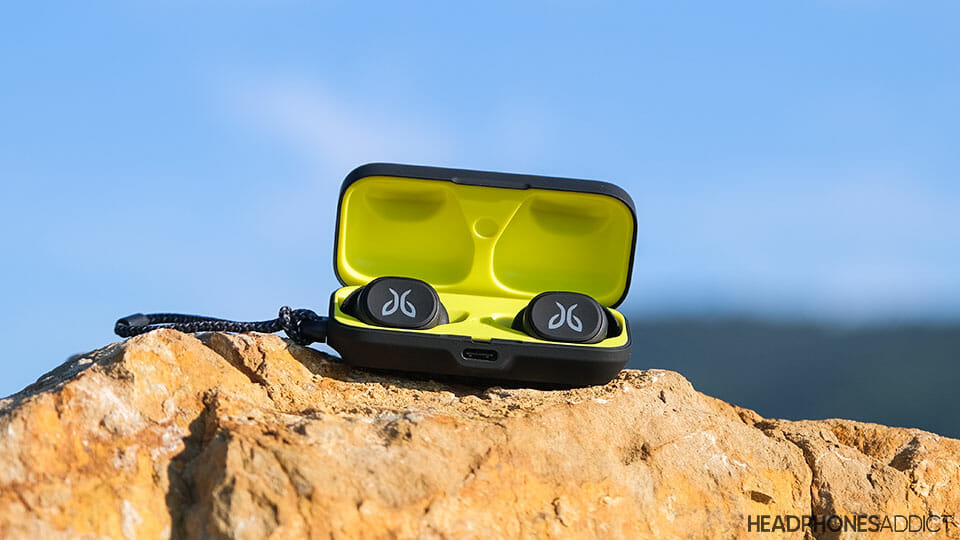
At the current price, these are still a compelling buy. You get the ruggedness and the customizability of the newer model, as well as excellent fit and stability, all for less money.
7. SoundPEATS H1
Dual hybrid drivers (dynamic and BA) produce excellent audio quality for the price.
But for maximum stability and comfortable fit, you have to use them with the included memory foam ear tips.
8. 1MORE ComfoBuds Mini
These are one of the smaller true wireless earbuds (most comfortable). They have ANC and transparency mode, both useful for cycling. The only bad thing is an occasional connectivity problem. But all is made good with a well-balanced sound.
9. Bose Frames Tempo

Bose Frames Tempo are a solid choice. These Bluetooth cycling headphones come in the form of sunglasses. Due to the design, you can hear all of the external noise to remain aware of your surroundings. However, sound leakage is strong.
How to Choose Headphones for Cycling That Fit Your Needs?
Match your needs to the right type of headphones.
- Good sound quality and stability are essential.
- To be able to hear is important outdoors but not inside.
Not all cyclists are the same, so ask yourself this question:
Where and How Will I Cycle?
- Cycling in busy streets with traffic: Get headphones with great awareness. Look for “hear-through” (ambient-aware) mode, open-ear design, or wireless bone conduction headphones since they don’t block the ears.

- Indoor cycling: Bluetooth earbuds and headphones are the best. But you don’t need awareness (you can ignore open-ear fit or ambient-aware modes).
- ANC (active noise cancelling) helps you focus on the workout for maximum results.
- Wired workout headphones are also fine (but most lack water resistance and have cables, yuck)

- Long-distance cycling: You need reliable Bluetooth headphones with long battery life, good awareness, and some water protection. When listening to music while cycling, you often get caught in the rain or meet an unexpected situation on the road.

As you can see, knowing which cycling headphones to choose is a case of figuring out what features are important to you.
Now you know how to find the right headphones for cycling that will fit you.
Key Features of Headphones for Cycling
The key features go beyond just sound. You need to consider both your listening comfort and your safety.
We’ve selected the following features as vital for cyclists:
Safety (As In: Awareness of Oncoming Traffic)
Safety is paramount, especially for road cyclists who need to hear the outside world around them.

So:
- Don’t block background noise like vehicle engines and car horns.
- Keep the volume low enough, so you can still hear the oncoming cars. It’s dangerous to do otherwise.
- Active noise-canceling is useful, but don’t use it when cycling with headphones. Turn the ANC off for better awareness.
- Turn on “awareness mode”, “hear-through” mode, or similar if your wireless Bluetooth earbuds support it. This way, you’ll hear traffic.
- Consider open-ear headphones (air-conduction & bone conduction headphones) that keep your ears open to the environment.
Bonus question: Is it even legal to wear headphones when riding a bike?
Stability (Get the Headphones to Stick Like Glue)
Cycling is often energetic and fast. And when there is movement, headphone stability is a problem.
So, what’s the solution?
- Get sports-oriented headphones with ear wings and hooks that stay in place even when you’re moving your head.

- Look for small earbuds (in-ear headphones) that aren’t bulky. The in-ear design is by far the best for the job.
On-ear and over-ear headphones are a definite no-go (won’t fit under a bike helmet and will create heavy wind noise).
Durability (Don’t Waste Your Money on Crap)
You don’t want to replace headphones every few months because they’ve broken.
A durable set of headphones is essential for cyclists with an active lifestyle and those who only cycle around town.
For example:
You get caught in heavy rain, and your headphones aren’t resistant to water…
What happens?
You’ll probably have to buy another pair. Water is cryptonite for electronics inside.
- Get cycling headphones with at least sweat resistance (if not fully waterproof). We all sweat on hot, sunny days or get caught in bad weather conditions.
How to know which are water resistant?
Look for a high IPX rating: minimum IPX4 or even better IPX6+.

Dust protection is another part of durable earbuds. For mountain biking in dusty environment, get headphones with an IP rating for dust (the first number in IP55). Any rating will give some protection, and 5 or 6 is the best.
Wired vs. Wireless (Which Is Better for You?)
Just get wireless.
- Wireless headphones have come a long way in recent years and have a lot to offer to active people, including cyclists.
- Wired headphones save you the hassle of charging but can tangle when moving. They’re okay if you cycle on a stationary bike (when movement is more uniform).
What are the key advantages of wireless headphones for cycling?:
Also, many wireless headphones have voice control for easy music and volume management.
Battery and Bluetooth (How Long Does It Last?)

If you are getting wireless headphones, you want a strong battery that will last your entire biking routine.
You don’t want the lithium battery to die in the middle of a tour, especially if you like to cycle long distances.
But is Bluetooth reliable?
Generally, Bluetooth today is reliable and stable, so you can listen to music without interruptions, even on windy or rainy roads.
Open Ears vs. Ambient-Aware Mode (Transparency mode)
Open-ear fit (in air-conduction and bone-conduction headphones) is slightly better for awareness than ambient-aware mode (in TWS and wireless headphones).
Leaving your ears open to the environment doesn’t block any sound in the vicinity. You’re always ready and scanning for a potential accident.

Ambient-aware modes can malfunction. Some only pick up certain noises (like human speech) and tone down other noises. But the engine hum of an approaching vehicle is more important when cycling.
If the ambient aware mode works well (like in the headphones on this list), then it’s almost the equivalent of having your ears open.
But if it’s not top-of-the-line, it can fail to pick up important sounds.
- So, if awareness is your top priority, get open-ear headphones.
- If it’s a high priority but not crucial, get headphones with a quality ambient-aware mode.
How are Cycling Headphones Different from Regular Headphones?
One of the key differences when looking for cycling headphones is that you want to prioritize stability over sound.
Why?
Good sound quality is important but completely useless if you are wearing true wireless earbuds that keep falling out.
Small earbuds that stick in ears and fit under a bike helmet are the best cycling headphones.
Besides, do you really think you’ll be focusing on sonic fidelity when you’re pushing down the pedals and breathing heavily?
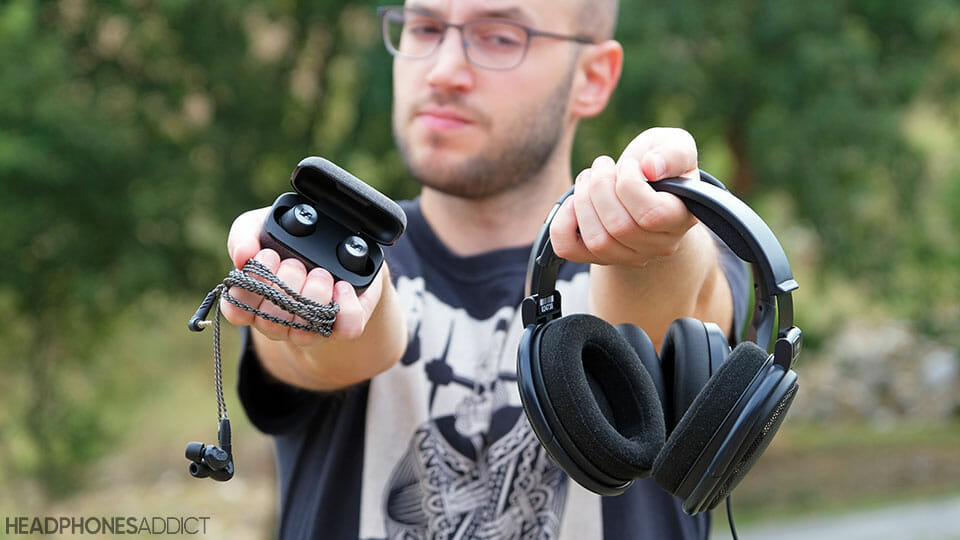
FAQ: Frequently Asked Questions
Can cyclists wear headphones?
Some countries and states allow you to wear headphones when cycling, while others don’t. In California, it’s illegal to cover both ears with headphones, while Texas has no such law. Always check your local laws to avoid getting fined. Read more about road rights and cycling laws.
Do headphones fit under a bike helmet?
Earbuds (in-ear headphones) are small enough to fit under most bike helmets. As long as the helmet doesn’t cover your ears, you will be able to wear most earbuds. Still, some helmets make it uncomfortable to use ear hooks, so check first.
Is it dangerous to cycle with headphones?
If you don’t fully block environmental noise and always check your surroundings before making a turn, you should be fine. The safest are open-ear headphones, like bone conducting headphones for cycling or earbuds with ambient-aware mode.
Can you wear AirPods while cycling?
Regular AirPods can fall off your ears when cycling due to movement and wind. They’re only suitable for slow cycling. Apple AirPods Pro are a better option since they have a better grip. Also, consider local laws if it’s legal to wear AirPods on both ears.

Matija Ferjan is a seasoned audio enthusiast reviewing headphones since 2015. He has personally tested hundreds of headphones and earbuds. He’s an active member of the Headphone Audio community and a true nitpicker, always looking for the “best-value-for-money” headphones.






